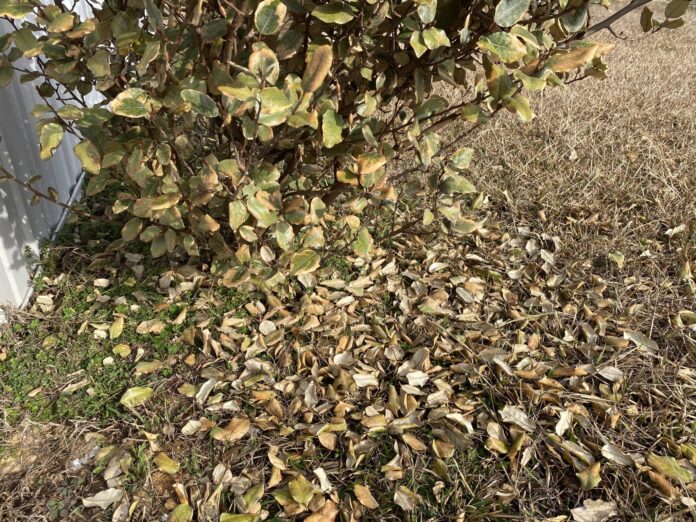AUBURN UNIVERSITY, Ala. – The hiring of Auburn University’s new football coach, Hugh Freeze, isn’t the only freeze Alabamians experienced in December. A stretch of temperatures in the teens and below–including one of the coldest Christmases in decades–caused damage to shrubs, trees and other plants across Alabama. This has left many homeowners asking if their plants will recover from this freeze damage.
Symptoms of freeze damage
Freeze damage on plants presents itself through a few symptoms. Mallory Kelley, an Alabama Cooperative Extension System home grounds, gardens and home pests regional agent, said the first symptom people will notice is a discoloration on the plant’s leaves.
“This discoloration can range from light yellow and tan blotches to jet black,” Kelley said. “This could be present on various spots on the leaf or on the entire leaf.”
For plants that are in pots or planters, this discoloration is often a bad sign. This is because they didn’t have the protection that plants in the ground typically have. Ground temperatures are often much warmer than air temperatures, so the ground acts as insulation for the plant’s roots. However, these plants may survive this damage, depending on the type of plant and its natural hardiness.
After the leaf discoloration, the leaves will most often begin to fall off the plant. Unlike their potted counterparts, the likelihood of trees and shrubs surviving this damage is much greater. Kelley said with these plants, most of the time there is no cause for immediate alarm.
“Most times this defoliation is no reason to panic, as most of our evergreen plants will leaf out again with no issues come spring,” she said.
Checking for dead material
After a freeze event, it will take months, or even spring temperatures, to definitively know if the plant survived the damage. However, Kelley said there is a test people can do now to check for dead material on the plant.
“Most times the dead material will be the tissue out on the tips of the branches and stems, as that is the newer and more susceptible tissue,” Kelley said. “Use your fingernail to scratch just below the bark to look for green and white, healthy looking material. Also, bend the branch slightly.”
If the area below the bark is brown and snaps off when bent, that plant material is dead.
“Whenever plant material is dead or damaged, we recommend that you always remove it immediately,” Kelley said. “Damaged material will collect water in the cracks and crevices and cause further rot down into the healthy material.”
To properly remove dead material, Kelley said to make cuts near the tip of the stem and continue further into the canopy of the plant. With each cut, examine the center of the stem.
“If there is brown discoloration in the center of the stem, continue to make cuts until that is no longer present,” Kelley said. “Once you see the green and white material, you have reached the healthy tissue.”
More information
More information about freeze damage on plants is available in the Alabama Extension publication Cold Injury to Ornamental and Fruit Trees available at www.aces.edu. Winter has just begun, so there will be plenty of additional cold snaps that require preparation. For information on protecting your plants from a freeze event, read Protecting Plants During Frost Advisories.
The Alabama Cooperative Extension System takes the expertise of Auburn University and Alabama A&M University to the people. Our educators in all 67 counties are community partners — bringing practical ways to better our homes, farms, people and the world around us. Our research extends knowledge and improves lives.























